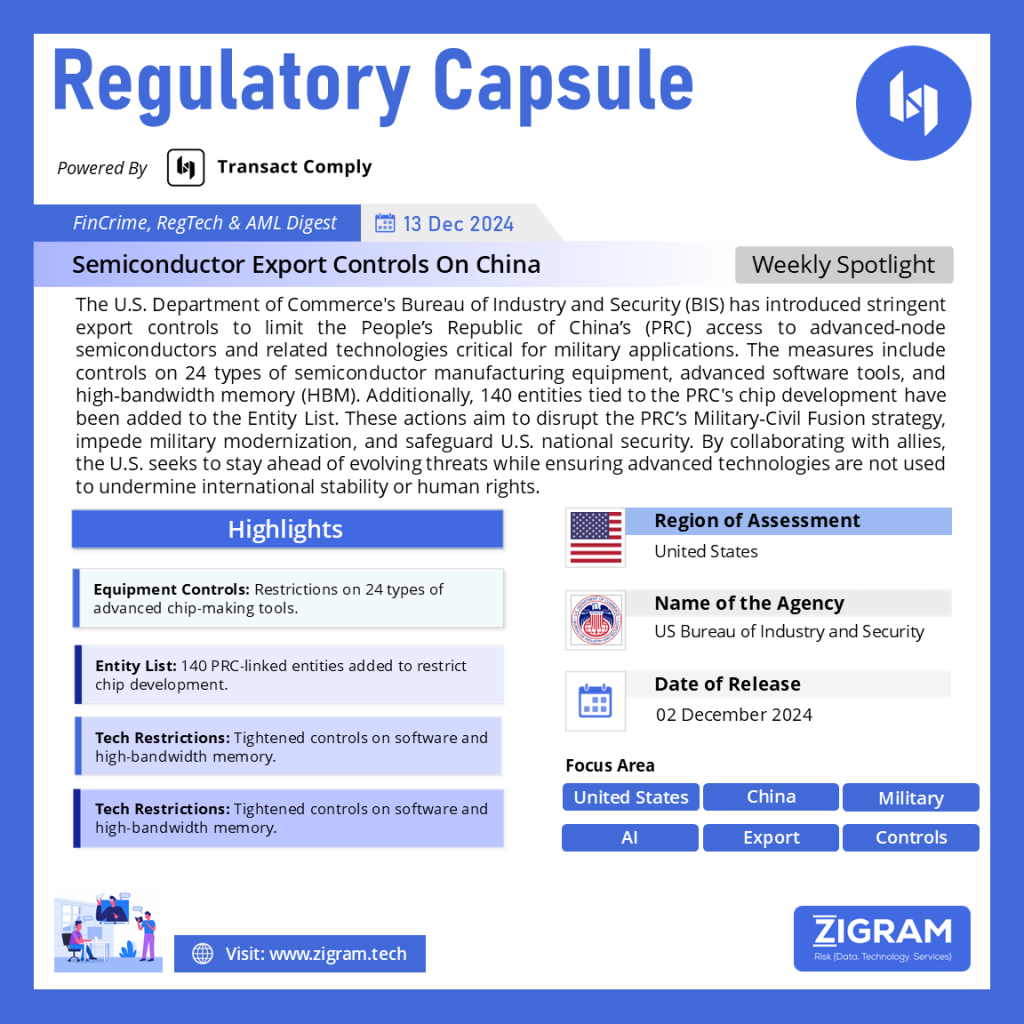Regulation Name: Semiconductor Export Controls On China
Publishing Date: 02 December 2024
Region: United States
Agencies: United States Department of Commerce’ Bureau of Industry and Security
The U.S. Department of Commerce’s Bureau of Industry and Security (BIS) has unveiled a comprehensive package of rules aimed at curbing the People’s Republic of China’s (PRC) ability to produce advanced-node semiconductors. These semiconductors are critical to next-generation weapon systems, artificial intelligence (AI), and advanced computing applications with significant military implications. This move underscores the Biden-Harris Administration’s strategy to impede the PRC’s military modernization efforts while safeguarding U.S. national security.
Strengthening Export Controls
The new regulations expand upon earlier measures to limit the PRC’s access to cutting-edge technology. Key highlights include:
Enhanced Equipment and Software Controls
24 types of semiconductor manufacturing equipment are now subject to new restrictions, including etch, deposition, lithography, and inspection tools essential for producing advanced-node integrated circuits.
Software tools for developing or producing advanced semiconductors, such as those increasing machine productivity, also face stringent controls.
Controls on high-bandwidth memory (HBM)—a critical component for AI and advanced computing—restrict its export and reexport under the advanced computing Foreign Direct Product (FDP) rule.
Expansion of the Entity List
BIS has added 140 entities and modified 14 others to the Entity List, encompassing semiconductor fabs, tool manufacturers, and investment firms aiding Beijing’s advanced chip development. These additions aim to directly disrupt PRC military modernization efforts.
New Foreign Direct Product (FDP) Rules
The Semiconductor Manufacturing Equipment (SME) FDP targets foreign-produced SME with links to destinations such as Macau or PRC entities in restricted groups.
The Footnote 5 (FN5) FDP focuses on entities aiding the PRC’s military through advanced-node semiconductor production.
Enhanced Software and Technology Restrictions
Electronic Computer-Aided Design (ECAD) and Technology Computer-Aided Design (TCAD) software used for designing advanced semiconductors are now more tightly regulated.
Software keys, granting access to critical hardware or software, are explicitly included under export control rules.
Rationale Behind the Measures
The PRC’s Military-Civil Fusion strategy, which seeks to integrate civilian and military resources, poses a significant threat to global security. Advanced semiconductors are pivotal to this strategy, enabling military AI applications, cyberweapons, and surveillance systems that undermine human rights and destabilize geopolitical landscapes.
“The PRC’s push for an indigenous semiconductor ecosystem is a direct challenge to U.S. and allied security,” stated Assistant Secretary for Export Enforcement Matthew S. Axelrod. “These actions ensure U.S. technology does not enable such ambitions.”
A Coordinated and Proactive Approach
The BIS actions align with the broader U.S. national security strategy, leveraging coordination with allies and partners to safeguard advanced technology. According to U.S. Secretary of Commerce Gina Raimondo, the package represents the most aggressive steps taken to address the PRC’s military ambitions through export controls.
BIS Under Secretary Alan Estevez emphasized the innovative and proactive nature of these measures. “We are staying ahead of the PRC by adapting to increasingly sophisticated threats and supply chains,” he said.
Implications for the PRC’s Semiconductor Goals
The Chinese Communist Party (CCP) has prioritized semiconductor self-sufficiency, recognizing integrated circuits (ICs) as vital to military and economic power. The PRC’s whole-of-society approach, incentivizing domestic firms to advance chip production, faces significant setbacks with the new U.S. measures.
Today’s rules continue to build on BIS’s interim final rules from October 2022 and subsequent updates in 2023 and 2024, reflecting an evolving response to the PRC’s strategies.
Conclusion
By implementing these expanded controls, the United States seeks to thwart the PRC’s progress in advanced AI and semiconductor technology, which could alter the future of warfare and surveillance. These actions not only reinforce U.S. leadership in global semiconductor technology but also protect the national security of the United States and its allies.
The BIS’s targeted measures represent a strategic milestone in countering adversarial use of advanced technologies, ensuring they do not threaten democratic values or international stability.
Read the details here.
Read about the product: Transact Comply
Empower your organization with ZIGRAM’s integrated RegTech solutions – Book a Demo
- #ExportControls
- #Semiconductors
- #NationalSecurity
- #USChinaRelations
- #AdvancedTechnology
- #AI
- #ChipRestrictions
- #MilitaryModernization
- #TechRegulations
- #SupplyChainSecurity
